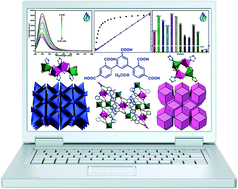当前位置:
X-MOL 学术
›
CrystEngComm
›
论文详情
Our official English website, www.x-mol.net, welcomes your feedback! (Note: you will need to create a separate account there.)
Structural diversity, magnetic properties, and luminescence sensing of five 3D coordination polymers derived from designed 3,5-di(2′,4′-dicarboxylphenyl)benozoic acid†
CrystEngComm ( IF 3.1 ) Pub Date : 2018-07-11 00:00:00 , DOI: 10.1039/c8ce00877a Liming Fan 1, 2, 3, 4, 5 , Yujuan Zhang 1, 2, 3, 4, 5 , Jinfang Liang 1, 2, 3, 4, 5 , Xiaoqing Wang 1, 2, 3, 4, 5 , Hongxiao Lv 1, 2, 3, 4, 5 , Jiang Wang 1, 2, 3, 4, 5 , Li Zhao 1, 2, 3, 4, 5 , Xiutang Zhang 5, 6, 7, 8
CrystEngComm ( IF 3.1 ) Pub Date : 2018-07-11 00:00:00 , DOI: 10.1039/c8ce00877a Liming Fan 1, 2, 3, 4, 5 , Yujuan Zhang 1, 2, 3, 4, 5 , Jinfang Liang 1, 2, 3, 4, 5 , Xiaoqing Wang 1, 2, 3, 4, 5 , Hongxiao Lv 1, 2, 3, 4, 5 , Jiang Wang 1, 2, 3, 4, 5 , Li Zhao 1, 2, 3, 4, 5 , Xiutang Zhang 5, 6, 7, 8
Affiliation

|
Based on the designed π-conjugated aromatic pentacarboxylate of 3,5-di(2′,4′-dicarboxylphenyl)benozoic acid (H5DDB) and bis(imidazole) ancillary linkers (bib = 1,4-bis(imidazol-1-yl)benzene, m-bimb = 1,3-bis(imidazol-1-ylmethyl)benzene, p-bimb = 1,4-bis(imidazol-1-ylmethyl)benzene), five 3D coordination polymers, namely, {Co2(HDDB)(bib)1.5(H2O)2]·H2O}n (1), {[Mn2.5(H2DDB)(HDDB)(bib)0.5(μ2-H2O)(H2O)1.5]·(Hbib)·0.5(H2bib)·0.5H2O}n (2), {[Cd2(HDDB)(bib)1.5(H2O)]·2.5H2O}n (3), {[Cd2(HDDB)(m-bimb)]·H2O}n (4), and {[Cd2(DDB)(p-bimb)]·2.5H2O·0.5(p-H2bimb)}n (5), have been obtained and characterized. Complex 1 is a 3D 3-fold interpenetrating (3,4)-c {83}2{85·9}-vtx net. Based on the binuclear {Mn2(COO)2} SBUs, as well as the trinuclear {Mn3(COO)4(μ2-H2O)2} SBUs, complex 2 shows a 3D 3,4,6-c 3,4,6T10 net with a point symbol of {3·72}2{32·73·8}{32·76·86·10}. Complex 3 displays an unprecedented 3D (3,4,4)-c net with a point symbol of {6·82}2{64·82}2{8·104·12} based on the binuclear {Cd2(COO)4} SBUs. Complex 4 shows an interesting 3D (3,10)-c {410·632·83}{43}2 net based on the quadrilateral tetranuclear {Cd4(COO)8} SBUs. Complex 5 exhibits a linear tetranuclear {Cd4(COO)4} SBU-based 3D (4,10)-c deh1 net with a point symbol of {3·45}2{34·412·510·614·73·82}. A variable temperature magnetic susceptibility investigation indicated that antiferromagnetic interactions exist between the neighbouring metal ions in 1 and 2. Fluorescence measurements showed that 3–5 are promising luminescence sensors for the detection of Cr(VI) anions (CrO42− and Cr2O72− anions) in aqueous solution.
中文翻译:

从设计的3,5-二(2',4'-二羧基苯基)苯甲酸生成的5种3D配位聚合物的结构多样性,磁性和发光感测†
基于设计的3,5-二(2',4'-二羧基苯基)苯甲酸(H 5 DDB)和双(咪唑)辅助接头的π-共轭芳族五羧酸酯(bib = 1,4-bis(imidazol-1 -基)苯,间-基= 1,3-双(咪唑-1-基甲基)苯,对-基= 1,4-双(咪唑-1-基甲基)苯,五个3D配位聚合物,即{ CO 2(HDDB)(BIB)1.5(H 2 O)2 ]·H 2 ö} ñ(1),{[锰2.5(H 2 DDB)(HDDB)(BIB)0.5(μ 2 -H 2 O) (H 2 O)1.5 ]·(Hbib)·0.5(H 2 bib)·0.5H2 O} n( 2),{[Cd 2(HDDB)(围嘴) 1.5(H 2 O)]·2.5H 2 O} n( 3),{[Cd 2(HDDB)(m-bimb)]·已经获得并表征了H 2 O} n( 4)和{[Cd 2(DDB)(p-bimb)]·2.5H 2 O·0.5(pH 2 bimb)} n( 5)。复合体1是3D 3倍互穿(3,4)-c {8 3 } 2 {8 5 ·9} -vtx网。基于所述双核锰{ 2(COO)2 }的SBU,以及三核{的Mn 3(COO)4(μ 2 -H 2 O)2 }的SBU,复杂2示出了3D 3,4,6-C 3,4,6T10网,其点符号为{3·7 2 } 2 {3 2 ·7 3 ·8} {3 2 ·7 6 ·8 6 ·10}。复合体3显示了前所未有的3D(3,4,4)-c网络,其点符号为{6·8 2 } 2 {6 4 ·8 2 } 2基于双核{Cd 2(COO)4 } SBU的{8·10 4 ·12} 。络合物4显示了基于四边形四核{Cd 4(COO)8 } SBU的有趣的3D(3,10)-c {4 10 ·6 32 ·8 3 } {4 3 } 2网。配合物5表现出基于线性四核{Cd 4(COO)4 } SBU的3D(4,10)-c deh1网,其点符号为{3·4 5 } 2 {3 4 ·4 12 ·5 10 ·6 14·7 3 ·8 2 }。可变温度磁化率研究表明,在1和2中的相邻金属离子之间存在反铁磁相互作用。荧光测量表明3–5是用于检测水溶液中Cr(VI)阴离子(CrO 4 2-和Cr 2 O 7 2-阴离子)的有前途的发光传感器。
更新日期:2018-07-11
中文翻译:

从设计的3,5-二(2',4'-二羧基苯基)苯甲酸生成的5种3D配位聚合物的结构多样性,磁性和发光感测†
基于设计的3,5-二(2',4'-二羧基苯基)苯甲酸(H 5 DDB)和双(咪唑)辅助接头的π-共轭芳族五羧酸酯(bib = 1,4-bis(imidazol-1 -基)苯,间-基= 1,3-双(咪唑-1-基甲基)苯,对-基= 1,4-双(咪唑-1-基甲基)苯,五个3D配位聚合物,即{ CO 2(HDDB)(BIB)1.5(H 2 O)2 ]·H 2 ö} ñ(1),{[锰2.5(H 2 DDB)(HDDB)(BIB)0.5(μ 2 -H 2 O) (H 2 O)1.5 ]·(Hbib)·0.5(H 2 bib)·0.5H2 O} n( 2),{[Cd 2(HDDB)(围嘴) 1.5(H 2 O)]·2.5H 2 O} n( 3),{[Cd 2(HDDB)(m-bimb)]·已经获得并表征了H 2 O} n( 4)和{[Cd 2(DDB)(p-bimb)]·2.5H 2 O·0.5(pH 2 bimb)} n( 5)。复合体1是3D 3倍互穿(3,4)-c {8 3 } 2 {8 5 ·9} -vtx网。基于所述双核锰{ 2(COO)2 }的SBU,以及三核{的Mn 3(COO)4(μ 2 -H 2 O)2 }的SBU,复杂2示出了3D 3,4,6-C 3,4,6T10网,其点符号为{3·7 2 } 2 {3 2 ·7 3 ·8} {3 2 ·7 6 ·8 6 ·10}。复合体3显示了前所未有的3D(3,4,4)-c网络,其点符号为{6·8 2 } 2 {6 4 ·8 2 } 2基于双核{Cd 2(COO)4 } SBU的{8·10 4 ·12} 。络合物4显示了基于四边形四核{Cd 4(COO)8 } SBU的有趣的3D(3,10)-c {4 10 ·6 32 ·8 3 } {4 3 } 2网。配合物5表现出基于线性四核{Cd 4(COO)4 } SBU的3D(4,10)-c deh1网,其点符号为{3·4 5 } 2 {3 4 ·4 12 ·5 10 ·6 14·7 3 ·8 2 }。可变温度磁化率研究表明,在1和2中的相邻金属离子之间存在反铁磁相互作用。荧光测量表明3–5是用于检测水溶液中Cr(VI)阴离子(CrO 4 2-和Cr 2 O 7 2-阴离子)的有前途的发光传感器。


























 京公网安备 11010802027423号
京公网安备 11010802027423号